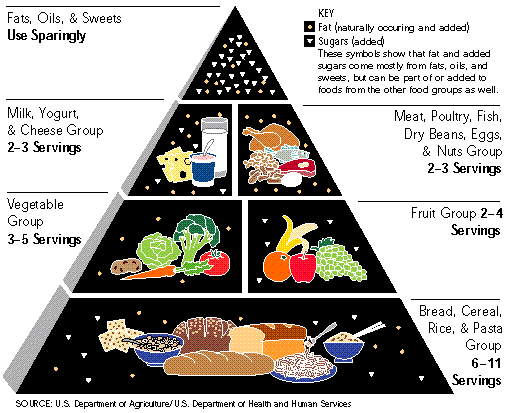Time was when people did not question the food that was placed on the table. Food was to eat, not for analyzing and rationalizing. But those days are over.
Consumers are more informed, more conscious of their health, and more discriminate. And with this change comes the questions about the quality and safety of the food we eat including both fresh produce and manufactured food.
So what's in fresh produce that should concern us? That would be pesticides, hormones, antibiotics and genetically modified food.
(1) Pesticides are primarily used to control pests and thereby maximize yield. The downside is that many pesticides are persistent and stay in fresh produce long after it has left the farm. In fact, pesticides make their way onto our dining table and into our body. The most common source of pesticides is fresh fruit and vegetables. According to the Daily Green, "if consumers get their USDA-recommended five daily servings of fruits and veggies from the 15 most contaminated, they could consume an average of 10 pesticides a day."
The Environmental Working Group (EWG) regularly issues a list of food products with the highest (The Dirty Dozen) and lowest levels (The Clean Fifteen) of pesticides. The EWG Shopper's Guide to Pesticides was developed based on data from nearly 87,000 tests for pesticide residues in produce conducted between 2000 and 2007.
(2) Hormones are common in animal-based food including meat and dairy, whereas pesticides are common in plant-based food. Farmers use growth hormones such as rBGH or rBST (short for recombinant bovine somotrophin growth hormone) to make cows produce more milk increasing yield by 10 to 15%. Cattle farmers also use hormones to speed up the growth of 'meat' cows. Unfortunately, the hormones stay in the milk.
In addition, rBGH cows produce abnormally high amounts of the growth factor IGF-1 which also goes into the milk. Some studies have even linked hormones in food to early onset of puberty in girls.
rBGH is produced under the trade name Posilac. Many dairy farmers use Posilac because they can produce more milk with fewer cows. There is no laboratory that can tell the difference between 'Posilac' milk vs. regular milk. Milk from treated cows is just as safe as milk from untreated cows. This has been affirmed by the U.S. Food and Drug Administration, World Health Organization, American Medical Association, American Dietetic Association and regulatory agencies in 30 countries.
What is interesting is rBGH is banned in Europe and other countries such as Canada and New Zealand mainly due to animal welfare issues, whereas it is still widely used in the US.
(3) Antibiotics are also commonly used to protect animals from diseases. It is estimated that 70% of all antibiotics in the US are used as prophylaxis for healthy animals. About 80 to 90% of these antibiotics are excreted into the environment to contaminate ground and water and it still is not clear how much antibiotics get into our food. According to Sustainable Table "Industrial farms have been mixing antibiotics into livestock feed since 1946...Today antibiotics are routinely fed to livestock, poultry, and fish on industrial farms to promote faster growth and to compensate for the unsanitary conditions in which they are raised."
(4) Genetically modified (GM) food ranges from plant-based food products to meat, dairy, and poultry. GM food comes from plants and animals genetically engineered to grow bigger and faster (thus getting rid of growth hormones), look better, and be more resistant to diseases (thus getting rid of pesticides and antibiotics).
However, many people are wary of the health consequences of GM food. After all, you can wash away pesticides but you cannot remove something that is inside the food itself. Plants were the first to be genetically modified and nowadays, almost every kind of fruit and vegetable in the supermarket from apples to soy exist in the GM version. Equally infamous are food products from cloned animals. In January 2008, the US FDA declared that milk and meat from cloned animals are safe for human consumption. Currently, there is no data available on the health effects of GM food.
Manufactured food, on the other hand, which comes in tins, jars or other packages has its own special additives each with its own set of concerns.
(1) Artificial sweeteners have been in our food supply since the mid 1900's when saccharin was accidentally discovered. Currently six sugar substitutes have been approved in the US including saccharin, aspartame, sucralose, neotame, acesulfame potassium, and stevia. Controversy still exists as to whether artificial sweetener usage is hazardous to your health. However, health authorities in the US and Europe have declared all the artifical sweeteners to be safe at current levels of consumption.
Aspartame appears to have engendered the most publicity. To get both sides of the story about the facts and myths about aspartame, check out the Aspartame Information Center and Sweetpoison.com.
(2) Other Additives may be food-grade preservatives to extend shelf life of products, food coloring and flavoring, as well as thickeners and emulsifiers. In Europe, those E's on the food packaging are codes for food additives. Similar numbers may also be found in food labels in Canada, Australia and other countries (without the E prefix which stands for Europe) but is still not widely used in the US. A complete list of food additives can be found in the Codex Alimentarius.
There are some additives that may be allowed in one country but prohibited in another. In the EU, for example, the yellow coloring tartrazine (E102) is not a permissible additive. Many other coloring additives are slowly being phased out in many countries due to potential carcinogenicity and toxicity. European consumers are wary of food products that contain a lot of "E" substances.
However, not all food additives are artificial or harmful. Alginates (E400-409), for example, which are seaweed extracts are popularly used as thickeners. Curcumin (E100) is from the turmeric plant and gives curry its yellow-red coloring. Vitamins and minerals are also sometimes added to fortify certain food stuffs.
(3) BPA (Bisphenol A) has become a hot issue during the last couple of years. Plastic bottles, cans, soup packets, and even baby formula containers contain BPA, which leaches from the packaging into the food and drinks we ingest. And if that isn't enough, in December 2007, the EWG checked for BPA in baby formula and found that most formulas are sold in cans lined with BPA-containing plastics. It was also found in the packaging of powdered formula manufactured by 4 out of the 5 top manufacturing companies in the US.
So what can we do? There are several ways to minimize the risk of ingesting these chemicals and some of them are listed here.
(1) Buy organic. The best way is to grow your own fresh produce but this is not always feasible. Fortunately, many fruit and vegetables are produced in an organic way, e.g. without the use of pesticides or artificial fertilizers. The downside of organic products is that they tend to be more expensive and they are not easily available. In their Shopper's Guide to Pesticides, the EWG recommends to buy organic those products listed under "The Dirty Dozen", e.g. those products with the highest pesticide levels. The "Clean Fifteen", however, are those products with the lowest levels of pesticides and can therefore be bought at conventional supermarkets. Organic meat is another produce that is recommended if you want to avoid hormones and antibiotics. Beware of "greenwashing" or "organic fraud" where producers and retailers may try to pass on nonorganic products as organic. A well-publicized case involved the company Aurora Dairy which was accused of selling phony organic milk.
(2) Check the labels. Make a habit of checking the labels of the products you buy including the additive food codes. Organic food labeling is based on certain criteria depending on the country. In the US, the official organic seal is given only to products that meet the criteria of 95 to 100% organic ingredients. Several cases of mislabeling have been reported. One of them involved Wal-Mart which added the word "organic" to its price labels. Additionally, the USDA organic labeling has lately come under fire for being too lax.
Some countries require labeling that differentiates between GM and conventional produce. This can also be checked through the price look up (PLU) code. PLUs consist of 4 to 5 digit numbered code and the first "prefix" digit of the code can tell consumers whether a produce is transgenic or not. So far 3 digits have been allocated for international recognition:
0 - Applies to all non-qualified produce and is generally presented without the leading "zero" digit. 8 - Genetically modified 9 - Organic.
(3) Get information. There are several 'watchdog' organizations including the Environmental Working Group, Cornucopia Institute, The Daily Green, Sustainable Table and the Union of Concerned Scientists.
Additives aren't going away and neither are pesticides, antibiotics and hormones. GM food will become more prevalent and, without doubt, there is probably a new additive in your food. Now, more than ever 'What's on Your Plate' is more important than ever. Be vigilant and be your own advocate.
You are what you eat!

 Starting Up An Aquaponics Set Up From See The Easy Way
Planting seeds in your aquaponics system can be a lot simpl
Starting Up An Aquaponics Set Up From See The Easy Way
Planting seeds in your aquaponics system can be a lot simpl
 Introduction To Of Some Lower Cholesterol Foodstuffs
Cholesterol is a fat-like element contained in the physique
Introduction To Of Some Lower Cholesterol Foodstuffs
Cholesterol is a fat-like element contained in the physique
 The Simplest Way To Lessen Your High Cholesterol By Natural Means
High-cholesterol is a major variable inside the countrywide
The Simplest Way To Lessen Your High Cholesterol By Natural Means
High-cholesterol is a major variable inside the countrywide